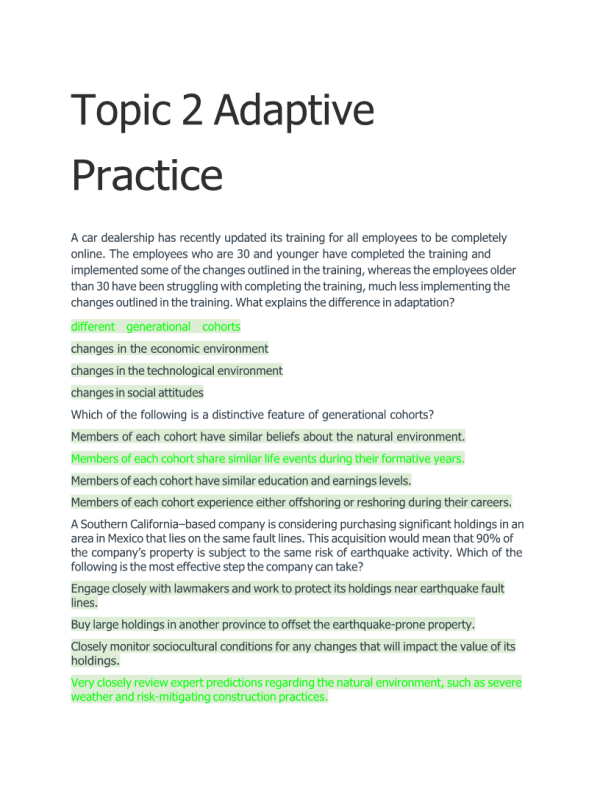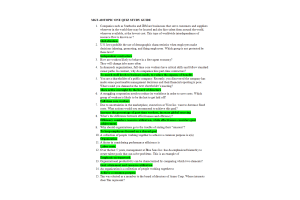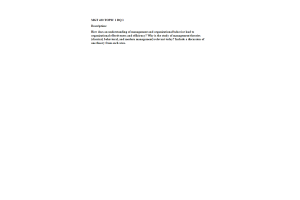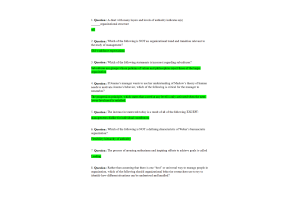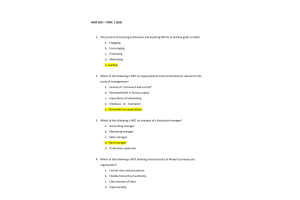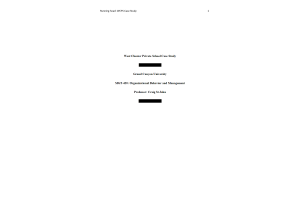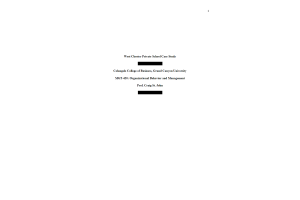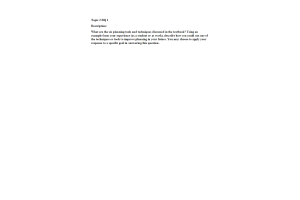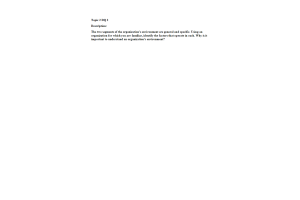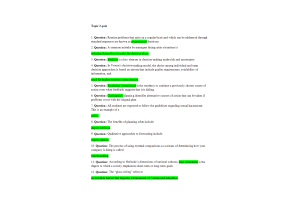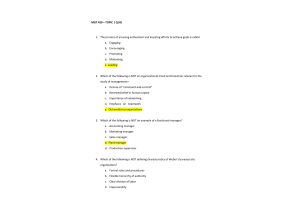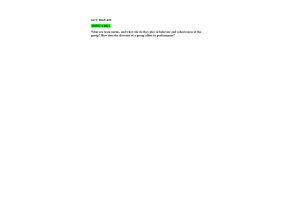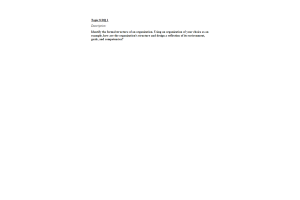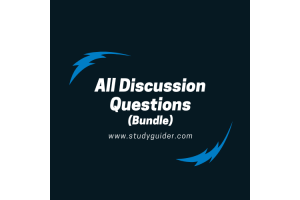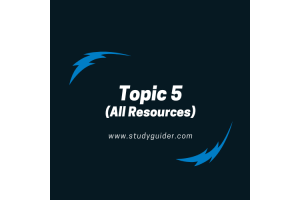MGT 420 Topic 2 - Adaptive Practice
- $39.00
- Question: A car dealership has recently updated its training for all employees to be completely online. The employees who are 30 and younger have completed the training and implemented some of the changes outlined in the training, whereas the employees older than 30 have been struggling with completing the training, much less implementing the changes outlined in the training. What explains the difference in adaptation?
- Question: Which of the following is a distinctive feature of generational cohorts?
- Question: A Southern California–based company is considering purchasing significant holdings in an area in Mexico that lies on the same fault lines. This acquisition would mean that 90% of the company’s property is subject to the same risk of earthquake activity. Which of the following is the most effective step the company can take?
- Question: The call center for a large cable and Internet provider recently invested heavily to upgrade the technology supporting its operations. To the surprise of middle managers, the less experienced workers have picked up the systems very quickly, while more experienced workers are struggling. This is an example of failing to take into account
- Question: Many print newspapers are experiencing financial problems because they have not been able to establish a steady stream of revenue for their online offerings. What type of current conditions is the leadership at newspapers failing to accurately assess?
- Question: Which tool do many governments use to control information?
- Question: Which of the following happens in high-uncertainty environments?
- Question: A mid-sized clothing retailer has a growing Internet presence and wants to establish a competitive advantage through delivery. How should the retailer leverage technology to outperform competitors in order to achieve this goal?
- Question: Why would multiple stakeholder groups work together?
- Question: Executives at a mid-sized software development firm have decided to abandon the traditional market the company serves in favor of an entirely different industry. In addition to being in a new industry the firm knows little about, many of its potential new customers are overseas. This decision is based on continued erosion of profit margins in the current business over the past six years. This is an example of
- Question: A small graphic design company employs a team of experienced artists, designers, and copywriters. It is a flat hierarchy that can move quickly to meet customer needs. What is this company an example of?
- Question: A large Internet retailer wants to establish a competitive advantage through delivery. Which of the following best describes how this can be achieved?
- Question: Emigrants from Somalia who now live in the U.S. want to organize a self-sustaining program that will provide farmers with an adequate water supply for their crops. How should this be organized?
- Question: Which type of innovation can be so successful that it changes the product (and market) completely?
- Question: As change, uncertainty, and complexity increase in organizational environments, the need for innovation Choose your answer here
- Question: ______ innovation is launched from lower organizational levels and diverse locations, including emerging markets.
- Question: Process innovation results in Choose your answer here
- Question: A small, family-owned business has developed a prototype for a new tractor. Because of limited resources, the family has hired an agricultural consulting business to evaluate the practicality of the device and to conduct testing of the product. According to Hamel’s wheel of innovation, the consultants are in charge of the
- Question: Company MNO has a reputation in its industry as a challenging place to work; the pay across the board is good, but many employees burn out because of the workload and stress. The new CEO has been with the company for 15 years, so he is familiar with the situation. He has been reading some leadership books, and one in particular emphasized some ideas on how to foster greater human sustainability, and he has taken these ideas to heart.
- Question: Which of the following represents the most effective step the company can take under the CEO’s leadership?
- Question: Many companies today employ a Sustainability Program Officer. What does this demonstrate?
- Question: The 3P’s of organizational performance are people, profit, and
- Question: A sporting goods manufacturer just issued a report announcing the compensation of its workers at all levels of the organization. At the same time, it also announced plans to reduce the ratio of its CEO’s pay to its machine operators’ pay from 100-to-1 to 40-to-1. This is an example of
- Question: How would a company prepare to transform itself into a sustainable business model?
- Question: Which of the following best describes the group(s) that should be concerned with sustainable development?
- Question: Problems with supplier quality control, rising foreign labor costs, and cheaper energy in the U.S. are explanations for
- Question: Which of the following is an example of a nontariff barrier?
- Question: Political risk and product price are related in that political risk lead to Choose your answer here
- Question: If a country moves away from protectionism, which of the following is a possible result?
- Question: Foreign and domestic partners cooperating for mutual gains is characteristic of a greenfield venture.
- Question: Which of the following was a result of NAFTA?
- Question: As a , Coca-Cola has extensive international business dealings in many foreign countries.
- Question: What is the relationship between using sweatshop labor and product prices?
- Question: In exchange for favorable financial terms, MegaBank promises a government official a position of VP at the end of their term. This is an example of
- Question: Which of the following is an example of corruption?
- Question: What is the relationship between using child labor and product prices?
- Question: Mel is the lead negotiator for a multinational corporation. He is meeting with representatives from Laos to discuss setting up a production facility there. Mel is seeking improvements to the standing facility to be made by the local area in exchange for healthy contributions to the area’s infrastructure, such as roads and schools. Which is the most effective argument Mel can offer to the representatives?
- Question: The tendency to view one’s culture as superior to others is called cultural intelligence.
- Question: Which of the following is a characteristic of the masculine dimension of values and national culture?
- Question: On a recent trip to the United States, Rana was struck by the frequency with which people used “I” and “me” in conversations and meetings. Rana’s observation is an example of which dimension of values and national culture?
- Question: With respect to the stages of culture shock, which of the following is characteristic of the small victories stage?
- Question: Janet returned from an overseas assignment for the company where she works. She describes the beliefs, values, and behaviors of the host country in unflattering terms. What is Janet’s behavior an example of?
- Question: The CEO of a large retailer feels that the chain’s expansion into Asia failed because of “cultural spectacles,” which limited vision and did not overcome the biases of the firm’s home country. How would you prepare the company’s leaders before the next international expansion effort?
- Question: Which of the following is the best setting in which to apply comparative management studies?
- Question: American management theories tend to place an emphasis on participation in leadership because of the nation’s moderate stance on power distance. This is an example of
- Question: Which of the following is an example of self-management?
- Question: The study of how management perspectives and practices differ among countries and cultures systematically is called
- Question: Pablo is in touch with his own emotions and genuinely interested in others. Pablo’s co- workers report that he is very skilled at making personal adjustments in cross-cultural
- Question: Being flexible and nonjudgmental are critical when interpreting and dealing with situations in which differences are present in
- Question: Fran’s manager relies heavily on information to help her make decisions. At a meeting, Fran disclosed that she had new access to a large data source. What action did Fran’s manager most likely recommend?
- Question: A project manager needs a person with good analytical competency. Whom should the manager select?
- Question: Erin excels at locating and using information to solve problems. She has a high level of technological competency.
- Question: Technological competency is the ability to
- Question: _____ is the process of analyzing data to produce useful information for decision makers.
- Question: UPS spends $1 billion per year on technology that analyzes over 1,000 pages of code to calculate optimum routes for drivers. Which is UPS’s most important strategic resource?
- Question: Wallace learns of a new opportunity on the horizon that he thinks his division could take advantage of. He raises the issue with the CEO, who immediately says, “Let’s go for it!” Wallace thinks to himself, “Wait wouldn’t it be better to gather information first and then reach a conclusion?” Wallace is probably an intuitive thinker.
- Question: Intuitive thinkers approach problem solving in a manner. rational and analytical
- Question: In 2010, hedge fund manager Anthony Ward purchased $1 billion worth of cocoa futures. This was a significant enough percentage of the available supply that he was able influence chocolate prices and earn a very good return.
- Question: If, after analyzing the data surrounding a problem in an uncertain environment, you are still unable to make a decision about the best course of action, you might consider consulting what type of thinker to help you?
- Question: Solving problems in a way that is and is a hallmark of intuitive thinkers. Select all that apply.
- Question: The risk of failure in a(n)
- Question: Defining a problem too broadly or too narrowly is an example of
- Question: There is debate among senior professionals at a supply chain conference. They cannot come to a consensus on social media’s impact on supply chain management over the next five years. This division suggests that any decisions made by these professionals at their companies
- Question: Your boss, an executive, informs you that the executive committee has decided to reduce the number of the lowest-paid workers so executives can earn their annual bonuses. You are concerned that this decision is
- Question: Which of the following is a common mistake when identifying and defining a problem?
- Question: In a rush to address a major production issue in your department, you decide to institute immediate changes. The managers in other areas are resisting. You have
- Question: At a software company, the executive asks your team of managers to address lagging revenue. Your team initiates a new marketing campaign to drum up more business, but revenues remain flat. What would you propose to be the problem?
- Question: Little-C creativity is distinctive from Big-C creativity in that it relies on left-brain thinking.
- Question: Entering negotiations with a potential customer, a supplier starts with an inflated price per part. They have a significant cushion to work with as they negotiate downward. They are trying to take advantage of
- Question: Task expertise, task motivation, and creativity skills are elements of self-confidence.
- Question: A business owner has recently begun a push to double the number of locations of his business. A friend suggests that he may have over-extended himself by expanding too rapidly. The owner continues to push through, trying to avoid the perception that he has made a mistake. The owner
- Question: An IT executive has asked each regional manager to be involved in a software vendor selection process. The IT executive hopes that their involvement will result in
- Question: When a student does not stop studying to have fun with friends or to pursue interests outside of school, the student will
- Question: For time management and the general process of planning to both be successful, what must a person have?
- Question: Objectives are specific results that one wishes to
- Question: In a meeting to discuss missed annual targets, mangers recap the year’s events. They can document instances of setting direction, measuring to ensure results, and creating structures. The group wants to do better next year. What would you propose?
- Question: If a company has a bad quarter and the Chief Financial Officer falls into a complacency trap, what is the expected result?
- Question: When a manager wants to improve her time management skills, what should she do?
- Question: Planning improves both coordination and
- Question: What type of budget is best suited for companies that have volatile changes in performance for each activity?
- Question: Bob, the CFO of a small company, is dating his assistant, Kelly. When Bob’s boss finds out, Bob is fired. This is an example of a violation of the company’s
- Question: What type of plan would most likely include a pricing strategy?
- Question: Tactical plans are also referred to as
- Question: Each year, when top managers assign resources to departments and activities company- wide, one particular department seems to never spend its available funds until the end of the year, and then spend it on items that weren’t planned and seem unnecessary. What action should the company take to avoid these situations?
- Question: For planning purposes, with which time span are most people comfortable working?
- Question: A company is experiencing a crisis due to new regulations preventing it from selling its products. What could the company have done to prevent this situation from happening?
- Question: What is the difference between a goal and a plan?
- Question: Which of the following would be the MOST important plan for a company that operates in a market where resources are scarce?
- Question: Benchmarking helps companies
- Question: Roger started the top management meeting by stating, “Today, we will begin the process of predicting what will happen in the future.” Roger was introducing the concept of
- Question: A contingency plan is also referred
- Question: You are going to be a keynote speaker at a large conference. You prepare an excellent speech accompanied by a PowerPoint presentation. When you get to the podium, you realize that your flash drive is not compatible with the flash drive at the podium. You are now stuck without the presentation.
- Question: What should you have done to anticipate the facility lacking the type of technology you needed?
- Question: In the hierarchy of objectives, what are the means?
- Question: Which of the following best describes the relationship between goals at lower levels and goals at higher levels within a hierarchy of objectives?
- Question: When all members of a team in charge of implementing a plan are encouraged to contribute to the plan, management
- Question: As the membership manager at a nonprofit, Caterina has annual goals that include new memberships sold, percentage of returning members, membership upgrades, and direct mailing membership conversions. Which of the following best describes Caterina’s goals?
- Question: Compared to standard planning, participatory planning takes time and the quality of the plans.
- Question: Which of the following best describes the distinguishing feature of verifiable work activities?
- Question: Management by objectives (MBO) depends on performance objectives, plans to achieve performance objectives, standards for measuring, and procedures for reviewing performance results. Which of the following elements allow MBO to occur?
